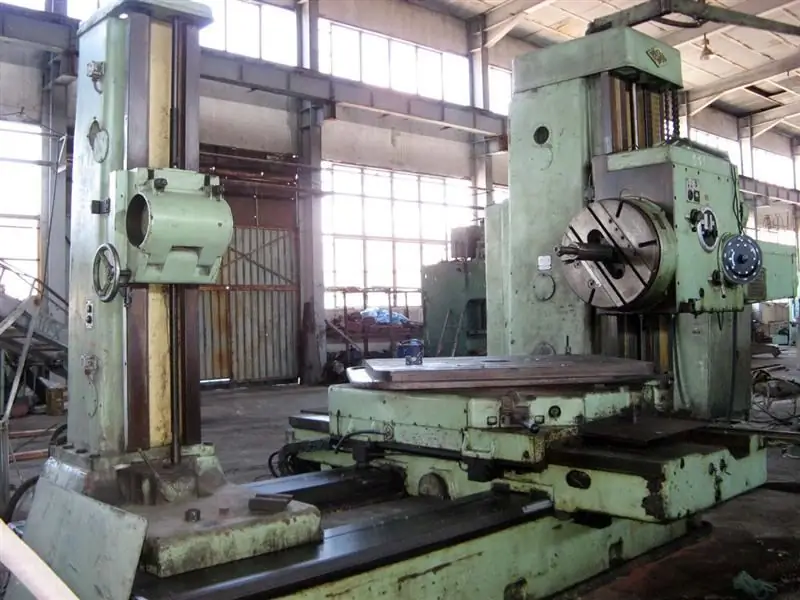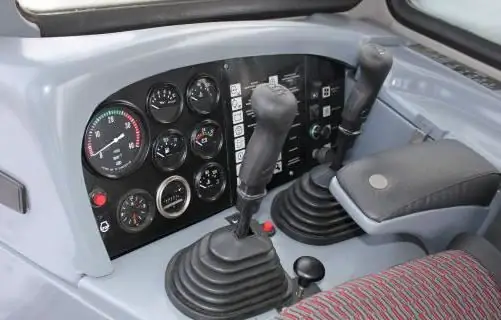2025 Author: Howard Calhoun | [email protected]. Last modified: 2025-01-24 13:10:45
For the nutrition of farm animals, it is necessary to harvest juicy feed - silage. This is very difficult to do without the use of special forage harvesters. Which of the existing modifications best meets modern requirements? Specifications and features - further in the article.
General information
A forage harvester is a device that is necessary for cutting plants for silage, then crushing them and collecting them in a car or trailer. The use of such agricultural equipment greatly facilitates the work of harvesting plants.
All forage harvesters have a similar design, differing in performance and some details. Agricultural machines have such parts - a frame, a header that cuts plants from the field, an auger for crushing silage, a collection container, wheels. In some modifications of harvesters there is no container for collecting silage, it can be replaced by a machine that moves parallel to agricultural machinery, or a trailer.
Combine "Polesie"
This agricultural forage harvester produced by the Belarusian plant "Gomselmash" is self-propelled, that is, it has its own engine to move across the field. Forage harvester "Polesie", or KSK-600, is designed for harvesting tall crops such as corn, sunflower.

The machine has the following specifications:
- YaMZ engine with a power of 235 hp provides not only high productivity, but also cost-effectiveness in use;
- productivity is about 108 tons of silage or 39 tons of hay per 1 hour of operation;
- mechanical sharpening of knives, which allows you to control their sharpness;
- large fuel tank capacity - 400L;
- 260 degree rotation of the silo duct, which is very convenient when loading material.
Besides, the Polesie forage harvester package includes 2 sets of headers (headers):
- The coarse crop header is used for harvesting sunflower and corn. At the same time, the stems are cut with knives, and the side dividers facilitate their passage into the combine, simultaneously lifting the fallen plants.
- The grass header has a field contour following system, which is convenient when harvesting silage.
In addition, the agricultural machine is equipped with a pick-up, the function of which is to prevent the loss of silage in windy weather and clean swath pick-up. It is also regulated bythe size of plant stems, moving up and down along the guides.
Jaguar harvester
The German company Claas is engaged in the production of agricultural machinery. Including the Jaguar 850 self-propelled forage harvester.

It has a high quality build and is designed for a long service life. "Jaguar" is one of the best selling forage harvesters in the world due to its good performance:
- diesel engine manufactured by Mercedes OM 460 LA with a capacity of about 412 hp. p.;
- chopping drum equipped with 24 knives;
- 100-tooth grain regrinder;
- rotate the silo line 190 degrees;
- stone detector;
- corn header and grass header;
- fuel tank capacity 1150L;
- transport speed up to 40 km/h;
- working speed - 16cm/h
The productivity of the agricultural machine is about 114 tons of silage per hour, or 50 tons of haylage. This technique is recommended for use on fields from 1.5 ha.
Combine "Don"
The Russian company Rostselmash, among other agricultural machines, also produces Don 680M self-propelled forage harvesters.

They are designed to harvest feed for livestock up to 500 heads. The harvester has the following technical characteristics:
- the presence of 3 modes forforage mass chopping, while the operator does not need to change knives, but only select the appropriate mode without leaving the cab;
- diesel engine YaMZ-238DK-1 with a power of 290 hp;
- high efficiency, which is achieved by attaching the shaft directly to the engine;
- high performance - about 100 tons of silage per hour or 25 tons of hay;
- the device is adapted to domestic climatic zones, including arid ones;
- thanks to the pick-up pressure springs, minimal material loss is achieved even in gusty winds;
- possibility to turn the silo duct 180 degrees;
- transport speed is 20 km/h;
- working speed is 9 km/h.
Besides, the Don forage harvester is unified with other Rostselmash machines, which makes about 60% of parts interchangeable. It also has a relatively low cost and a guarantee for 2 years of use or 1200 hours.
The disadvantages include relatively low engine power, fewer knives on the chopper, the need for frequent replacement of rubbing elements (pulleys, gears, sprockets). With all the visible advantages and disadvantages of the combine, it has a relatively low cost, which explains its popularity among the owners of domestic agricultural land.
Trailed harvesters
For relatively small farms and fields, it is not necessary to purchase a full-fledged self-propelled harvester, as this is unprofitable. FROMtrailed forage harvesters are great for small jobs:
- Semi-mounted harvester PSK-1, 8.
- Trailed harvester SK-2, 6A.
- Trailed rotary harvester KRP-2, 0.
- Challenger II Plus trailed forage harvester.
- Trailed harvester TURBO 1250.
These varieties of trailed silage harvesters are the most popular among farmers.

Conclusion
Modern agriculture is hard to imagine without the use of various combines, including for harvesting silage and hay. The use of such machines allows not only preparing juicy and dry animal feed, but also clearing the field of plant stems. The choice of machine depends on the size of the field, the number of cattle, the variety of cultivated plants.

There are many both domestic and foreign modifications of harvesters, each of which has its own special characteristics. They also differ in cost: Russian ones are usually cheaper both to buy and to operate.
Recommended:
Forage crops: cereals, legumes. List of forage crops

This article tells you which plants are the most suitable for use as animal feed. Cereals, legumes, as well as gourds forage crops are described here
Funny company names: an overview of the most interesting names, ideas and options

Many owners want to give their businesses original and unusual names. This can often lead to unexpected results. Funny company names are not as rare as they might seem at first glance
Diamond boring machine: types, device, operating principle and operating conditions

The combination of a complex cutting direction configuration and solid-state working equipment allows diamond boring equipment to perform extremely delicate and critical metalworking operations. Such units are trusted with the operations of creating shaped surfaces, hole correction, dressing of ends, etc. At the same time, the diamond boring machine is universal in terms of application possibilities in various fields. It is used not only in specialized industries, but also in private workshops
Duration of the operating cycle. What is an operating cycle?

The company will not have problems with a lack of current assets if the management begins to strictly control the proportions between equity and debt capital, through which operations are financed
Bulldozer T 25: description, specifications, engine and operating features

The T-25 bulldozer, produced by the Promtractor plant in Cheboksary, is characterized by increased cross-country ability and excellent technical characteristics. This model is used mainly by enterprises of the industrial and oil and gas complex

